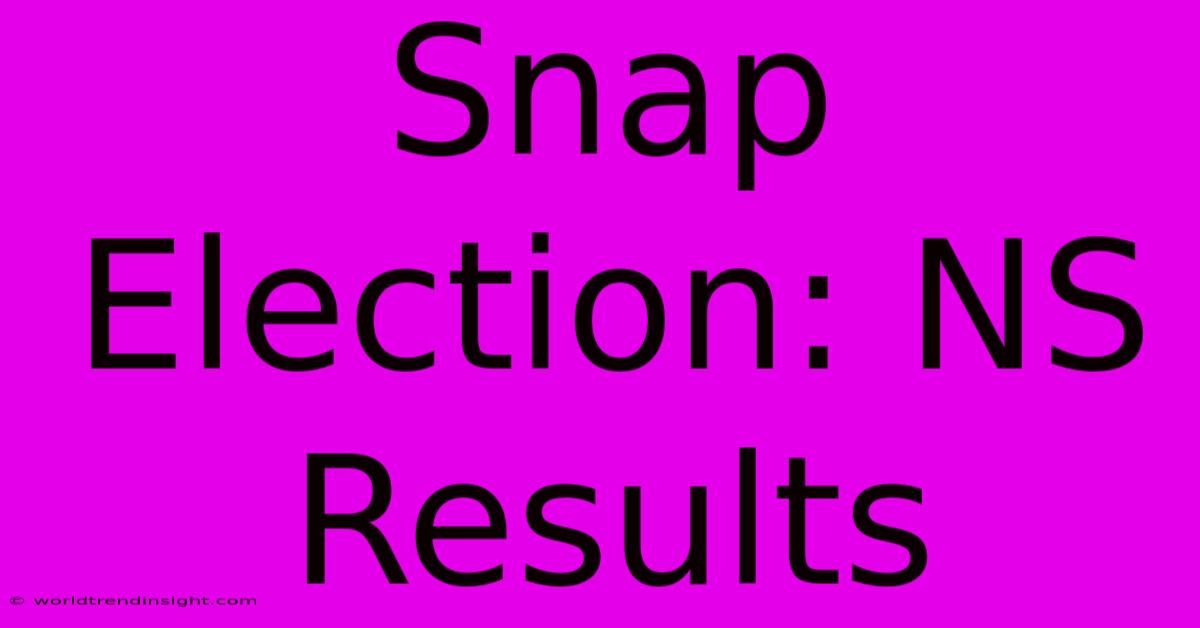Snap Election: NS Results

Discover more detailed and exciting information on our website. Click the link below to start your adventure: Visit Best Website Snap Election: NS Results . Don't miss out!
Table of Contents
Snap Election: NS Results - A Rollercoaster Ride and What We Learned
Hey everyone, so, the snap election in NS… whew! What a ride, right? I’m still kinda reeling, to be honest. I remember watching the results come in, glued to my phone, practically gnawing my nails off. It was a total nail-biter, especially given the pre-election polls which, let's be honest, were all over the place. They're rarely totally accurate, are they?
My Initial Predictions (and Why They Were Totally Wrong!)
Before the election, I'd done some of my own amateur political analysis. I’d looked at the voter turnout in previous elections, compared the candidates' platforms, and even made a spreadsheet (don’t judge!). I was sure the Liberals would win a majority, maybe even a landslide. Boy, was I wrong!
My analysis completely missed the mark on the impact of social media campaigning and the youth vote. Turns out, my spreadsheet didn't account for the power of TikTok and Instagram in swaying younger voters. I should have known better, considering how much time I spend scrolling myself! It's a humbling experience, let me tell you.
Understanding the NS Election Results: Key Takeaways
The final NS election results were a shock to many. The Progressive Conservatives, against all odds, secured a comfortable majority. This is a clear indication of the changing political landscape in Nova Scotia. There are a few key things I think we can learn from this whole thing.
- Don't rely solely on pre-election polls: As I painfully discovered, polls can be wildly inaccurate. They offer a snapshot in time, and things change rapidly, especially with social media influencing public opinion.
- Social media is a game changer: Political parties effectively used social media marketing strategies to reach and connect with voters, especially younger demographics. My analysis was seriously lacking in this area. I need to up my social media game, stat!
- Local issues still matter: While national issues play a role, the election results showed the significance of local concerns like healthcare and the economy in influencing voters' choices. I neglected this aspect, focusing too much on national trends.
- Unexpected events can shift the tide: You never know what unexpected events might impact voter sentiment. It's crucial to stay informed and adapt your analysis accordingly. This is where constant monitoring of news outlets becomes crucial.
Moving Forward: Lessons Learned (and What I'll Do Differently Next Time)
So, what have I learned? Firstly, humility is key. Secondly, I need to diversify my research methods. I'll be paying more attention to grassroots movements, local news sources, and the impact of social media on different age groups.
My next political analysis will involve:
- More in-depth social media analysis: I'll track trends, hashtags, and engagement levels across platforms.
- Local news monitoring: I'll delve deeper into local news coverage, including smaller publications and community forums.
- Ground-level research: I’ll try to include more interviews with voters to understand their concerns directly.
The NS snap election was a learning experience, to say the least. It highlighted the complexities of political forecasting and the unexpected turns events can take. But, hey, that’s politics, right? It’s a messy, unpredictable business, but that’s what makes it so fascinating. And perhaps, a little less predictable next time!

Thank you for visiting our website wich cover about Snap Election: NS Results . We hope the information provided has been useful to you. Feel free to contact us if you have any questions or need further assistance. See you next time and dont miss to bookmark.
Featured Posts
-
Bernardo Imprisoned La Macaza Update
Nov 27, 2024
-
Guardiolas Sacking Citys Limit
Nov 27, 2024
-
Rbnz To Slash Rates By 50 Bps
Nov 27, 2024
-
Make My Trip Global Payments Update
Nov 27, 2024
-
Butterball Turkey Abuse Video Resurfaces
Nov 27, 2024
